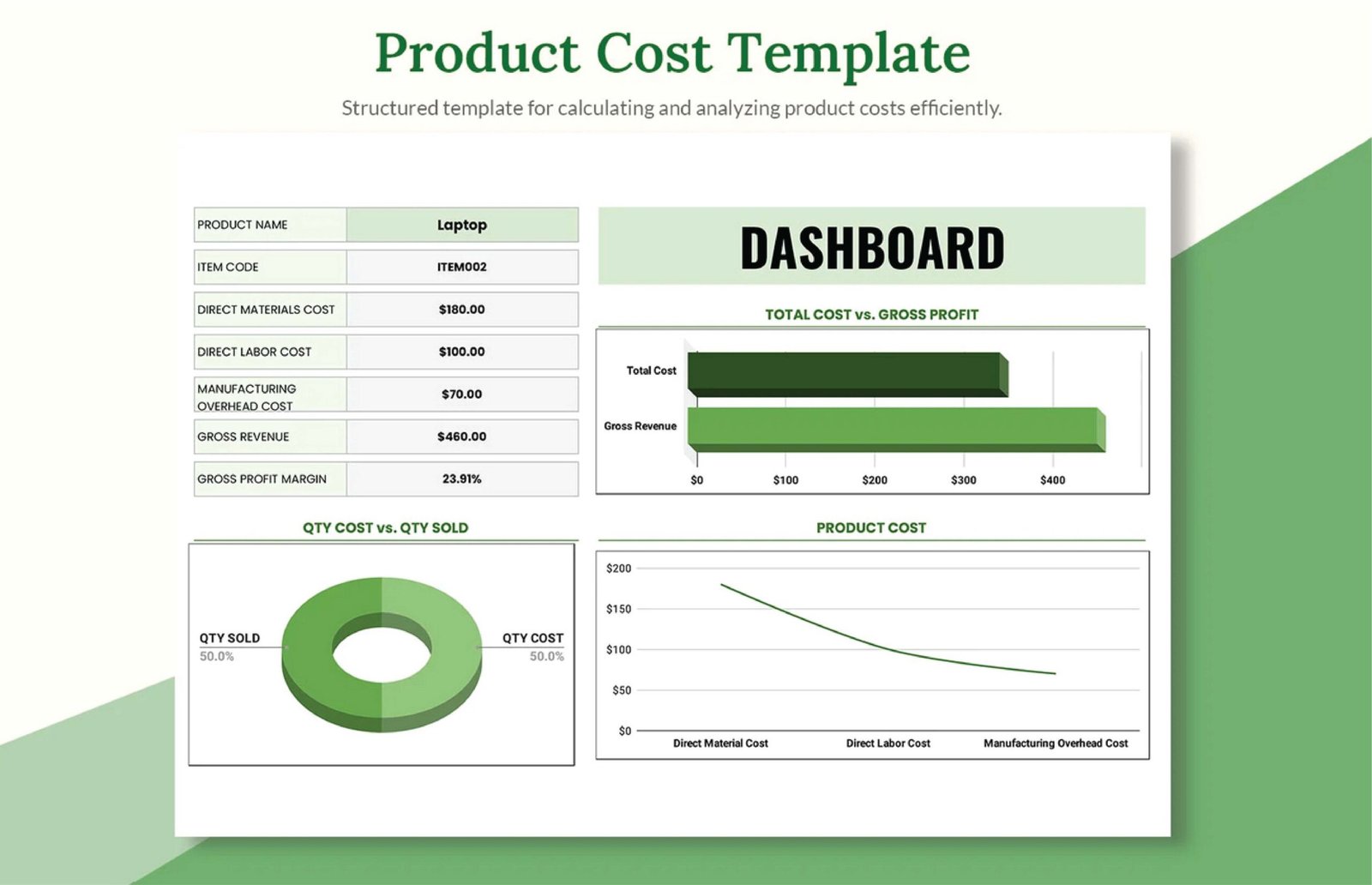Product cost analysis is a vital process in project management, helping organizations track, manage, and optimize their expenses related to production. A Product Cost Analysis Template serves as a structured tool for this process, offering a detailed framework to capture and analyze cost data effectively.
Understanding Product Cost Analysis:
Product cost analysis involves examining all expenses associated with producing a product. It includes direct costs like materials and labor and indirect costs such as overhead and administrative expenses. The primary goal is to determine the total cost of production and identify areas for cost reduction or efficiency improvements.
A product cost analysis template simplifies this process by providing a pre-designed format to enter and analyze cost data. This template helps project managers and financial analysts organize cost information systematically, enabling them to make informed decisions.

8 Essential Key Components:
Direct Materials Costs: This section captures all expenses related to raw materials required for production. It includes the cost of purchasing materials, transportation, and any additional handling fees. Accurately tracking direct material costs is crucial for understanding the primary input expenses and managing inventory effectively.
Direct Labor Costs: This component covers the wages and salaries paid to employees directly involved in the production process. It includes regular wages, overtime, and any bonuses or incentives related to production. Properly recording direct labor costs ensures that labor expenses are accounted for in the overall cost structure.
Manufacturing Overheads: Manufacturing overheads include all indirect costs associated with production that cannot be directly attributed to a specific product. These costs encompass utilities, depreciation of equipment, rent for production facilities, and maintenance costs. Allocating these costs appropriately helps in determining the true cost of production.
Related Article: Project Risk Register Template
Administrative Expenses: This section includes costs related to administrative support functions such as management salaries, office supplies, and general administrative overheads. While these expenses do not directly contribute to production, they are essential for running the organization and must be factored into the overall cost analysis.
Fixed and Variable Costs: The template should distinguish between fixed costs (which remain constant regardless of production volume) and variable costs (which fluctuate with production levels). Understanding this distinction helps in analyzing cost behavior and forecasting future expenses based on different production scenarios.
Cost Per Unit: This component calculates the cost of producing a single unit of the product. It is derived by dividing the total production costs by the number of units produced. Tracking cost per unit is essential for pricing strategies and assessing profitability.
Break-Even Analysis: This template often includes a section for break-even analysis. This analysis determines the point at which total revenues equal total costs, helping businesses understand the minimum sales volume needed to cover production expenses.
Cost Variance Analysis: This section compares actual costs with budgeted or standard costs to identify variances. Analyzing cost variances helps in understanding discrepancies and taking corrective actions to manage costs effectively.
Related Article: Agile Project Management Template
Defining the Key Benefits:
- Enhanced Accuracy: A well-structured product cost analysis template ensures that all cost components are accounted for accurately. This reduces the risk of errors in cost calculations and provides a clear picture of production expenses.
- Improved Decision-Making: By providing detailed cost insights, the template supports better decision-making regarding pricing, budgeting, and cost control. It enables managers to identify cost-saving opportunities and make informed strategic decisions.
- Streamlined Reporting: The template facilitates standardized reporting of cost data. This streamlines communication and ensures that stakeholders receive consistent and accurate cost information.
- Efficient Cost Management: With a clear framework for capturing and analyzing cost data, organizations can manage their production costs more effectively. This leads to improved cost control and better financial performance.
Related Article: Multiple Project Management Dashboard
Creating and Using a Product Cost Analysis Template:
- Define Cost Categories: Begin by outlining all relevant cost categories based on the components mentioned earlier. Customize the template to include these categories and ensure that all necessary details are captured.
- Input Data: Enter cost data into the template regularly. Ensure that the data is accurate and up-to-date to reflect the current cost structure.
- Analyze Data: Use the template to analyze cost data and identify trends, variances, and areas for improvement. Perform regular reviews to monitor cost performance and make adjustments as needed.
- Generate Reports: Utilize the template to generate cost reports for internal and external stakeholders. Ensure that the reports are clear, concise, and provide actionable insights.
- Review and Update: Periodically review and update the template to accommodate changes in cost structures, production processes, or organizational needs. This ensures that the template remains relevant and useful.
Related Article: Kanban Project Management Tools

Challenges in Product Cost Analysis:
- Data Accuracy: Ensuring the accuracy of cost data can be challenging. Inaccurate data may lead to incorrect cost calculations and misinformed decisions. Regularly reviewing and verifying data can help mitigate this issue.
- Complex Cost Structures: Complex cost structures with multiple components can be difficult to manage. Simplifying cost categories and using a structured template can help in addressing this challenge.
- Cost Variability: Costs can fluctuate due to various factors such as changes in material prices or labor rates. Accounting for these variations in the template requires careful monitoring and adjustment.
- Integration with Other Systems: Integrating the cost analysis template with other financial or project management systems can be challenging. Ensuring compatibility and data consistency across systems is crucial for effective cost management.
Related Article: Construction Project Management
Defining the Future Trends:
Conclusion:
A Product Cost Analysis Template is an essential tool for managing and analyzing production costs.
Related Article: Product cost management


